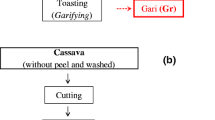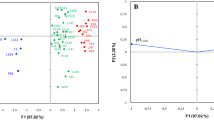Summary
Organisms isolated during the fermentation of cassava tubers, as practised for ‘fufu’ production, includedBacillus subtilis, Pseudomonas alcaligenes, Lactobacillus plantarum, Corynebacterium manihot, Leuconostoc mesenteroides andPseudomonas aeruginosa. All isolates displayed amylase activity. Optimum growth and amylase activities of isolated organisms was at 42°C and between pH values 5 and 6. Isolated organisms also displayed similar patterns of antibiotic resistance. Plasmids purified from isolates could not be transferred or maintained inEscherichia coli RR1 cells.
Résumé
La fermentation des tubercules de manioc a été effectuée comme on le pratique traditionnellement pour la production de ‘fufu’. On a utilisé quatre variétés différentes de tubercules de manioc. Au cours du processus de fermentation, un grand nombre d'espèces microbiennes agissent de concert pour dégrader l'amidon contenu dans les tubercules. Les glycosides cyanogènes, linamarine et lotaustraline sont également degradés. Les microorganismes isolés au cours de la fermentation des tubercules de manioc, comme on la pratique pour la production de ‘fufu’, comprennentBacillus subtilis, Pseudomonas alcaligenes, Lactobacillus plantarum,Corynebacterium manihot, Leuconostoc mesenteroides andPseudomonas aeruginosa. Tous les microorganismes isolés révèlent une activité amylolytique. Les croissances et activités amylolytiques des microorganismes isolés montrent un optimum à 42°C et un pH entre 5 et 6. Les organismes isolés exhibent aussi des profils semblables de résistance aux antibiotiques. Les plasmides purifiés des isolats n'ont pas pu être transférés ni maintenus dans des cellules d'Escherichia coli RR1.
Similar content being viewed by others

References
Abe, M. O. &Lindsay, R. C. (1978) Evidence for a lactic streptococcal role in Nigerian acid cassava (Manihot esculenta Crantz) fermentations.Journal of Food Protection 41, 781–784.
Akinrele, I. A. (1964) Fermentation of cassava.Journal of Science, Food and Agriculture 15, 589–594.
Anon. (1980)11TA Research Highlights for 1979. Ibadan. ISS No. 331–4340, pp. 32–33.
Birnboim, H. C. &Doly, J. (1979) A rapid alkaline extraction procedure for screening recombinant plasmid DNA.Nucleic Acids Research 7, 1513–1523.
Bolivar, F. &Backman, K. (1979) Plasmids ofEscherichia coli as cloning vectors. In Wu, R. (ed.)Methods in Enzymology, Vol. 68, pp. 245–267. Academic Press, New York.
Bolivar, F., Rodriguez, R. L., Greene, P. J., Betlack, M. C., Heynecker, H. L., Boyer, H. W., Crosa, J. H. &Falkow, S. (1977) Construction and characterization of new cloning vehicles II. A multipurpose cloning system.Gene 2, 95–113.
Castric, P. A. (1975) Hydrogen cyanide, a secondary metabolite ofPseudomonas aeruginosa.Canadian Journal of Microbiology 21, 613–618.
Cohen, S. N., Chang, A. C. Y. &Hsu, L. (1972) Non chromosomal antibiotic resistance in bacteria: Genetic transformation ofEscherichia coli by R-factor DNA.Proceedings of the National Academy of Science USA 69, 2110–2114.
Collard, P. &Levi, S. (1959) A two stage fermentation of cassava.Nature 183, 620–621.
Colman, A., Byers, M. J., Priminose, S. B. &Lyons, A. (1978) Rapid purification of plasmid DNAs by hydroxyapatite chromatography.European Journal of Biochemistry 91, 303–310.
Cowan, S. T. &Steel, K. J. (1974)Manual for the Identification of Medical Bacteria, 2nd edn. Cambridge. Cambridge University Press.
Delange, F.,Bourdoux, P.,Camus, M.,Gerard, M.,Mafuta, M.,Hanson, A. &Ermans, M. (1976) The toxic effect of cassava on human thyroid. InProcedings of the 4th Symposium of the International Society for Tropical Root Crops, 237–242.
Henner, D. J. &Hoch, J. A. (1980) TheBacillus subtilis chromosome.Microbiological Reviews 44, 57–82.
Ketiku, A. O. &Oyenuga, V. A. (1970). Preliminary report on the carbohydrate constituents of cassava root and yam tuber.Nigerian Journal of Science 4, 25–30.
Knowles, C. J. (1976) Micro-organisms and cyanide.Bacteriological Reviews 40, 652–680.
Linton, A. H. (1978) Antibiotics, animals and man —an appraisal of a contentious subject. In Woodbine, W. (ed.)Antibiotics and Antibiosis in Agriculture, pp. 315–343. Butterworths, London.
Mielenz, J. R. (1983)Bacillus stearothermophilus contains a plasmid borne gene for α-amylase.Proceedings of the National Academy of Science USA 80, 5975–5979.
Ngaba, P. R. &Lee, J. S. (1979) Fermentation of cassava (Manihot esculenta Crantz).Journal of Food Science 44, 1570–1571.
Okafor, N. (1977) Micro-organisms associated with cassava fermentation for garri production.Journal of Applied Bacteriology 24, 279–284.
Okafor, N. (1983) Indgenous fermented foods.Nigerian Institute of Food Journal 1, 33–37.
Onwueme, I. C. (1978)The Tropical Tuber Crops, pp. 109–148. John Wiley & Sons, London.
Rodgers, P. B. &Knowles, C. J. (1978) Cyanide production and degradation during growth ofChromobacterium violaceum.Journal of General Microbiology 108, 261–267.
Smith, H. W. (1978) Antibiotic resistance in bacteria and associated problems in farm animals before and after the 1969 Swann Report. In Woodbine, M. (ed.)Antibiotics and Antibiosis in Agriculture, pp. 345–357. Butterworths, London.
Yamaguchi, K., Nagata, Y. &Maruo, B. (1974) Isolation of mutants defective in α-amylase fromBacillus subtilis: Genetic analyses.Journal of Bacteriology 119, 416–424.
Author information
Authors and Affiliations
Rights and permissions
About this article
Cite this article
Nwankwo, D., Anadu, E. & Usoro, R. Cassava-fermenting organisms. World J Microbiol Biotechnol 5, 169–179 (1989). https://doi.org/10.1007/BF01741840
Received:
Accepted:
Issue Date:
DOI: https://doi.org/10.1007/BF01741840



